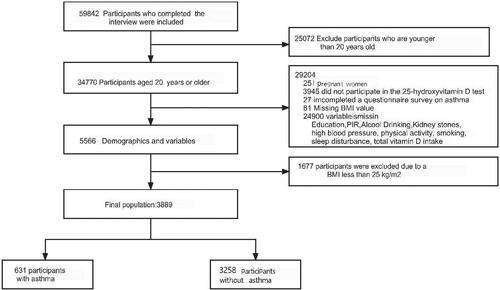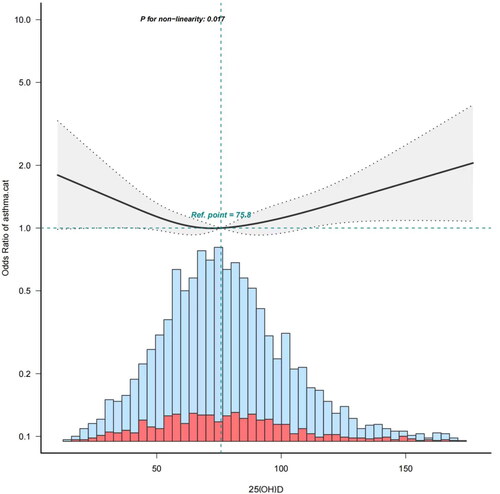Figures & data
Figure 1. Flow chart of this study. This study included 59,842 participants who completed the interviews. Of these, 34,770 participants aged >20 years were included for analysis. Exclusion criteria included pregnant women (n = 251), BMI < 25 kg/m², missing variables (25(OH)D (n = 3945), asthma (n = 27), BMI (n = 81), various covariates (n = 24,900)). Ultimately, the cross-sectional analysis comprised 3889 participants from six NHANES cycles conducted between 2007 and 2018.

Table 1. Demographic characteristics of participants by 25-hydroxyvitamin D concentration category.
Table 2. Associations between covariates and asthma incidence.
Table 3. Association between 25-hydroxyvitamin D concentration and asthma.
Figure 2. Curve fitting. Using a fully adjusted model, RCS (restricted cubic spline) regression analysis revealed a non-linear association (p = 0.017) between 25(OH)D levels and asthma, with an inflection point at approximately 84.95 nmol/L. Odds ratio between 25-hydroxyvitamin D level and asthma. Solid and dashed lines represent predicted values and 95% confidence intervals. Red represents people with asthma, and blue represents people without asthma. Adjusted for age, sex, race/ethnicity, education level, household income, smoking status, physical activity, hypertension, diabetes, kidney stones, sleep disturbance, and dietary vitamin D intake.

Table 4. Threshold effect analysis of the associations between 25(OH) D concentration and asthma.
Figure 3. Stratified analyses based on additional variables. Subgroup analyses by sex, age, diabetes, sleep disturbance, and smoking status showed no significant interactions, confirming the robustness of the results. The association between 25-hydroxyvitamin D level and asthma according to basic features. Except for the stratification component itself, each stratification factor was adjusted for all other variables (age, sex, race/ethnicity, education level, household income, smoking status, physical activity, hypertension, diabetes, kidney stones, sleep disturbance, vitamin D intake).

Supplemental Material
Download MS Word (23.7 KB)Data availability statement
Publicly available datasets for this study can be found online.The repository/repositories name and accession numbers are available online at http://www.cdc.gov/ nchs/nhanes.htm.
